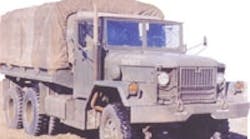A CTI system offers significant productivity gains to off-highway operators — they can adjust tire pressure from a panel inside the cab to match driving conditions. For example, on hard surfaces an operator can raise tire pressure to optimize rolling resistance, thus optimizing fuel economy and tire life. Conversely, on soft surfaces such as sand, bog, or snow, the operator can reduce pressure to improve tire-to-ground contact area and optimize traction. Likewise, tire pressure control can enhance life of a road, whether it is a highway, secondary, or temporary road.
Wheeled military vehicles and offhighway vehicles such as trucks in the logging industry have been prime candidates. More emphasis is now being placed on commercial applications such as the trucking industry. Companies have tried various methods of central tire inflation, routing air through the wheel bearings.
A new design worked out by Timken Co. specialists routes air under the bearing. John Schmidt, Timken’s market manager — heavy duty — automotive, explains that the design includes a pair of tapered roller bearings that have a sealed air passage beneath them. Air is routed through an air manifold ring, which is positioned against the spindle shoulder. The air continues to pass through a sealed air passage under the bearings until it reaches a sealed chamber in the hub cap area, where it is routed ultimately to the rotating tire. “Most existing systems require the axle to be disassembled and reworked prior to completing a retrofit. In contrast, a system using Timken CTI bearings does not require any significant modification.” Mr. Schmidt further explains that these bearings replace existing bearings and most connections can be made outside the bearings. Benefits include no rifle drilling of spindles or hubs, no spindle modification, and few hub modifications. Mr. Schmidt feels that “...installation of the whole system is easier, takes less time, and is accomplished at lower cost,” than alternatives.
Current common truck-wheel bearing bores are about 2½ to 3½ in., though others will become available as conditions warrant. These systems can readily withstand 50 to 100-psi normal tire pressures.
